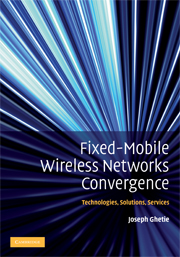Book contents
- Frontmatter
- Contents
- Disclaimer
- How the Book is Organized
- List of Figures
- List of Tables
- Preface
- Acknowledgments
- Acronyms
- Part I Wireless Communications: Networking and Management
- Part II Cellular Mobile Radio Networking and Management
- Part III Fixed Wireless Technologies: Networking and Management
- Part IV Fixed Wireless Cellular Mobile Networks Convergence and Integration
- Part V Fixed Wireless Cellular Mobile Networks Convergence: Standardized Networking Solutions
- Part VI Fixed-Mobile Convergence Services, Industry Trends, and Implementation Issues
- 18 QOS in Fixed Wireless Cellular Mobile Convergent Networks
- 19 The Economics of Fixed Wireless Cellular Mobile Networks Integration
- 20 Fixed-Mobile Convergence Implementation: Status, Trends, and Issues
- References
- Index
19 - The Economics of Fixed Wireless Cellular Mobile Networks Integration
from Part VI - Fixed-Mobile Convergence Services, Industry Trends, and Implementation Issues
Published online by Cambridge University Press: 21 August 2009
- Frontmatter
- Contents
- Disclaimer
- How the Book is Organized
- List of Figures
- List of Tables
- Preface
- Acknowledgments
- Acronyms
- Part I Wireless Communications: Networking and Management
- Part II Cellular Mobile Radio Networking and Management
- Part III Fixed Wireless Technologies: Networking and Management
- Part IV Fixed Wireless Cellular Mobile Networks Convergence and Integration
- Part V Fixed Wireless Cellular Mobile Networks Convergence: Standardized Networking Solutions
- Part VI Fixed-Mobile Convergence Services, Industry Trends, and Implementation Issues
- 18 QOS in Fixed Wireless Cellular Mobile Convergent Networks
- 19 The Economics of Fixed Wireless Cellular Mobile Networks Integration
- 20 Fixed-Mobile Convergence Implementation: Status, Trends, and Issues
- References
- Index
Summary
Economic Drivers of Fixed-Mobile Convergence
Although the title of this section includes the word “economics”, it is not the intent here to provide an economic analysis of fixed-mobile convergence implementations beyond some general considerations. It is not a secret that cost considerations can make or break any technical solution. The convenience of having one mobile phone that works transparently across all wireless networks is very appealing. However there are cost considerations that make such services economically justifiable. Three economics terms are used that need short explanation: Return on Investment (ROI), Compound Annual Growth Rate (CAGR), and Average Return Per Unit (ARPU).
Return on Investment (ROI), or rate of return, is the ratio of money gained relative to the money invested. It is usually calculated on an annual basis. ROI is also used to give a general qualification for a sound investment that brings profit as opposed to losing money. Compound Annual Growth Rate (CAGR) is the cumulative annualized growth rate that takes into account the cumulative effect of investment or growth over a period of time; five years for example. Average Return Per Unit (ARPU), as used in mobile telephony, indicates the revenue generated per unit, on a monthly basis, as the result of subscription and usage of services. Addition of a new service increases the ARPU.
If we consider a working network infrastructure, the cost of building a Fixed-Mobile Convergent network can be quantified by calculating the value of the following main components:
Cost of the initial design of the FMC network;
[…]
- Type
- Chapter
- Information
- Fixed-Mobile Wireless Networks ConvergenceTechnologies, Solutions, Services, pp. 378 - 389Publisher: Cambridge University PressPrint publication year: 2008



